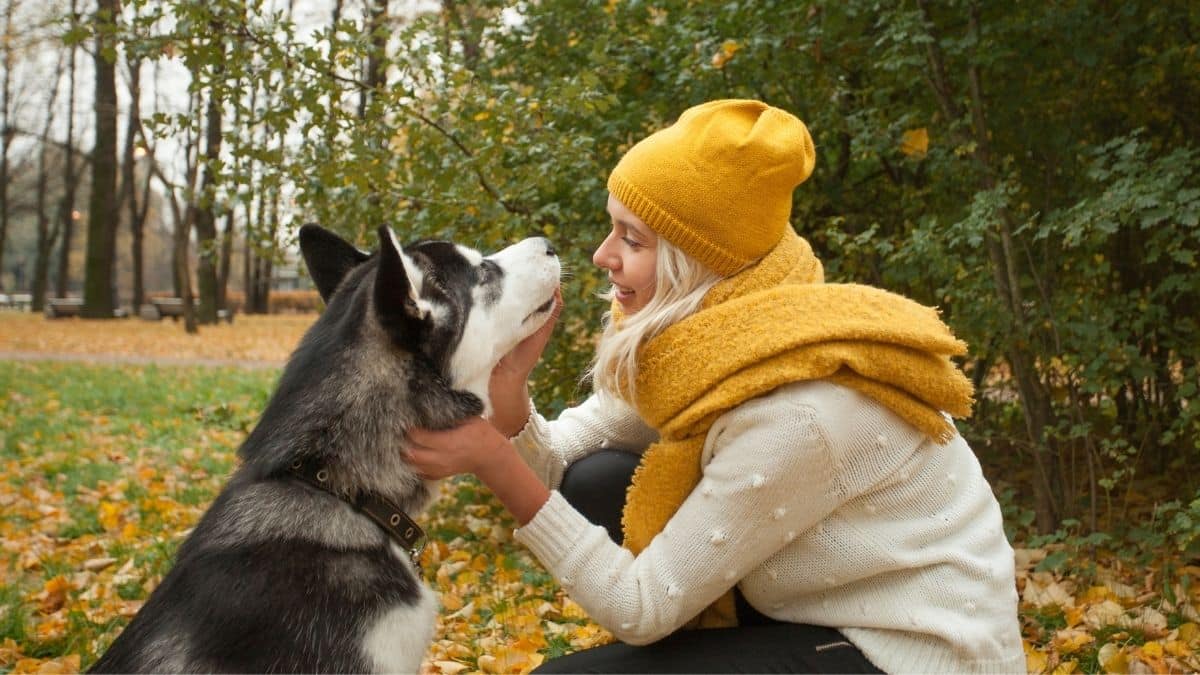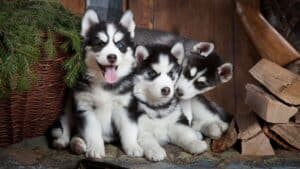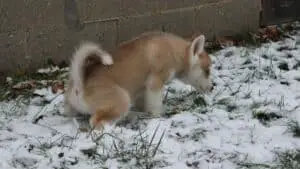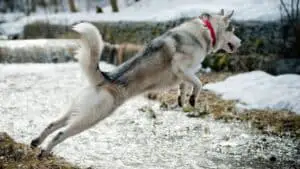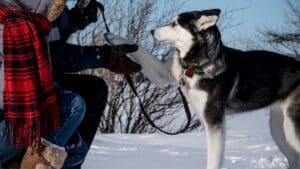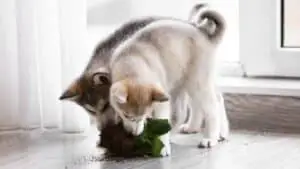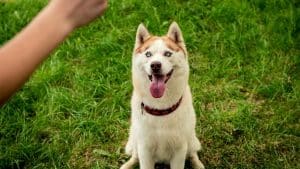Training Siberian Huskies – Everything You Need To Know
Training your dog can be time-consuming and patience-testing, but if it is done correctly, training can also be one of the most important and rewarding times in any dog owner’s life. When it comes to training your Siberian Husky in particular, initial frustrations and setbacks can soon lead to a happy, playful, and well-behaved companion.
Training your Siberian Husky will require commitment, patience, and consistency. For first time owners of Siberian Huskies, training this intelligent, independent breed of dog can seem a daunting task, but these characteristics can be your greatest weapon in the training process. If you are firm about the training process and use lots of positive reinforcement, there is almost no limit to what you can teach your Husky.
Whether house training your Siberian Husky pup, hammering home good behaviors, or trying to teach an old dog new tricks, taking a consistent, kind, and committed approach to training your Husky dog will pay off in spades over the long term. Regardless of
Table of Contents
Start your husky training early, make your life easy
Training your Siberian Husky should start from an early age. For most Husky owners, this will be as soon as you bring your Husky pup home. It is even possible to begin initial training and teaching at around six weeks of age.
Whenever possible, it is best to begin your Husky’s training while they are still a puppy. Although not impossible, it is usually harder to train older dogs as they will already have ingrained behaviors and may be less inclined to obey you in the initial stages of training.
Make learning fun for you and your husky!
One of the best ways to cement good behavior and weed out bad behavior when training your Husky pup is to make training a time of fun and reward. They will be much more likely to obey your instructions and cues if their training is done in a positive, upbeat environment.
You can do this by structuring training sessions in a way that suits your Husky’s natural schedule. This could mean turning playtime into a training opportunity, as Huskies are naturally fun, playful dogs. In fact, if you use the principle of positive reinforcement in your training, then almost any situation in which you interact with your Husky dog presents an opportunity to learn something new!
Positivity is important
Any dog owner who has done even the most basic research into dog training will be familiar with the term ‘positive reinforcement’. But what exactly is positive reinforcement? Does it mean that I have to bribe my Husky to behave?
In short, positive reinforcement entails encouraging (or reinforcing!) good behaviors with rewards such as treats, pats, or playtime. Bad behavior is not punished under the positive reinforcement process; it is simply ignored.
If your Husky demonstrates bad behavior or starts to act up, the best way to teach them is by saying a firm, hard ‘no’, while maintaining eye contact. Ideally, you would then have your Husky pup demonstrate good behavior and give them a reward.
Positive reinforcement is not about bribing your Husky pup either. Instead, your puppy should be the one to take the initiative and demonstrate the action or behavior of their own volition before being rewarded.
Eventually, you will not need to constantly give your Husky treats or rewards for doing the right thing. Their natural intelligence will soon take over, and they will simply know what to do without being prompted or rewarded.
It is a good idea to phase out your treats and rewards slowly, however, to avoid confusing your Husky puppy while he is still learning!
Take your cues from your Husky’s body language
In the course of training your Siberian Husky, try and be alert to and aware of his body language. You will find that your Husky is a natural communicator if you know what to look out for.
Huskies communicate through their bodies. If you notice that he is becoming tired or bored, take a break from training and start again another day.
Siberian Huskies are a breed of dog with a short attention span. They can get bored easily, and will want to move on to the next attraction. In this situations, it may be difficult to get your dog’s attention. Try not to get frustrated during these times. Instead, focus on your next training session when your Siberian Husky is in a better, more productive mood.
Some common signs that your Husky might be bored or tired include:
- Listlessness
- Whining
- Biting
- Digging
- Pawing
- Barking
- Gnawing
In short, if your Husky starts behaving like a grumpy toddler, it might be time to call it quits for the day!
Consistency is king
Create a schedule for training your Siberian Husky that has regular, consistent, short training sessions.
Your dog is not the only one who will need to learn discipline during the training process! It also takes a lot of determination and discipline on the owner’s behalf to adhere to a rigorous schedule, but commitment and consistency is the best way to train your Siberian Husky. And of course, your training will also progress faster if you stick to a regular and disciplined schedule.
Don’t let potty training drive you potty
Arguably one of the most daunting, and potentially one of the messiest, aspects of training any dog is house training.
To have a long, happy life with your Siberian Husky, you will need to establish the rules around potty training early on in his life. This is particularly true if you don’t have constant access to a backyard or other outdoor area for your Husky to do his business in!
There are a few key common rules you should stick to when it comes to potty training your puppy.
- Establish a consistent process and routine around house training.
- Keep control over your puppy’s access to food and water.
- Use positive reinforcement for good bathroom behavior – basically, for doing their business outside!
- Regularly exercise your puppy to keep them regular.
- Closely observe your puppy and learn the warning signs that an accident might be about to occur!
Taking command and teaching commands
Ultimately, as part of your Husky training, you will want to teach your Husky several key basic commands. The most commonly taught commands include: sit, stay, down, and come.
Each of these basic commands can be taught by following simple, easy-to-follow steps. To keep life simple for both you and your dog, only ever teach one command to your Husky dog at a time. This is proper training etiquette and will prevent your dog from becoming confused between all the different things you are trying to teach him.
When teaching your dog these commands, remember that you have assumed a leadership role with him. He will respond to your commands, your body language, and your tone of voice. It is important to remain positive throughout all your training efforts so that your dog is happy and content whenever it comes time to train.
We have put together a step by step guide for puppy owners on the best ways to teach your puppy several key commands and behaviors. The same steps will work for adult dogs too, but you will need to be very firm and diligent when training older canines, as they will already have their own ideas about what does and does not constitute good behavior!
Crate training for huskies: a sin or a savior?
One of the most commonly used methods for regulating and moderating puppy behavior is crate training. Although the cries and whines that will emerge from your puppy in the early days of crate training may cause you some concern, the use of crates to encourage good puppy behavior is pretty widely accepted.
The crate takes advantage of your puppy’s natural tendency to seek out a quiet place or a refuge. If used properly, the crate can become something of a sanctuary for your puppy.
Crates are good for both housetraining – your puppy is far less likely to soil his own bed! – and for other aspects of puppy training, such as preventing your puppy from chewing your furniture.
To maximize the potential of your crate training, try to avoid these common mistakes:
- Don’t use the crate as a place of punishment, or your puppy may come to fear it.
- Don’t leave your puppy in his crate for too long: build use of the crate into your schedule and ensure you are still getting plenty of one on one time with your pup.
- If you have a very small puppy – under six months – then don’t leave your puppy in there for more than four hours. There is only so much strain a tiny bladder can take!
- Keep at the crate training method until your puppy can remain in your home by himself without destroying your furniture or belongings.
Frequently Asked Questions
Are Huskies really that hard to train?
Huskies have a reputation as headstrong, stubborn dogs. Because of this, they also have a reputation as hard-to-train dogs.
This reputation is perhaps undeserved. Although Huskies are strong-willed and independent, they are also fast to catch on and extremely intelligent. If you maintain a consistent schedule and stick to the training process with diligence, then you will find that your Siberian Husky will take on his learning with ease.
After all, if Huskies can be trained to pull heavy sleds for miles across ice and snow, they can certainly be taught to sit and stay!
What is the best age to train a Husky?
As with any breed of dog, the best time to train your Siberian Husky is when he is still a puppy.
You will be able to encourage good behaviors from a young age and establish a pattern of positive reinforcement with your Husky that can continue for many years to come, well into their adulthood.
That being said, it is not impossible to train an older Husky – or any older dog for that matter – but such an endeavor might be more suitable for experienced dog owners, with years of training under their belts.
How do you train an old Siberian Husky?
In many ways, training an older, adult Siberian Husky is much the same as training a young Siberian Husky puppy. The same principles of positive reinforcement and a strict, consistent schedule remain the same, however, you may need to dedicate a bit more time to stamp out any ingrained bad behaviors that your adult Husky may have acquired over the years.
Some dog owners believe that some aspects of training can actually be easier in older dogs. House training in particular can be less of a headache in an older dog, simply because he can hold his bladder for much longer than a little puppy can!
Are Huskies good for first-time dog owners?
If it is your first time owning a dog, you may like to consider a less headstrong, wilful breed than the Siberian Husky. They do require more time, commitment, and consistency than other dog breeds, demanding a certain level of confidence and experience that some new dog owners might not have.
That being said, if you are willing to commit the requisite time to train and teaching your Siberian Husky, there is no reason that a patient, the diligent first-time dog owner should avoid a Siberian Husky. Only you can judge whether or not you will be a good, committed owner.

